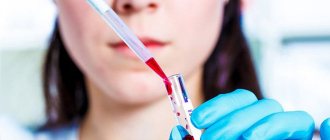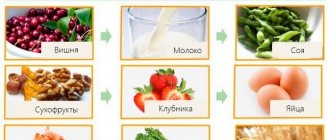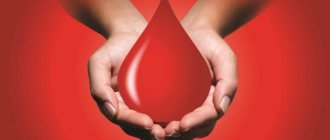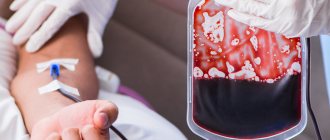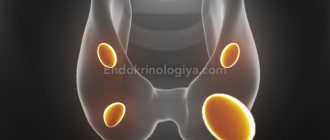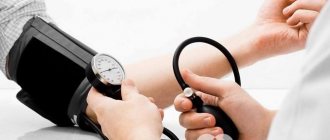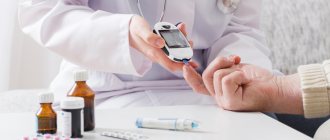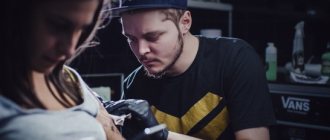Let's figure out how to properly donate blood for sugar. The accuracy and reliability of the sugar test result (with or without a sugar load) determines the correctness of the final diagnosis. It is important not only to comply with standard methods and rules when implementing the research methodology, but also to correctly collect biomaterial and prepare the patient himself.
It is known that more than 70% of errors are made precisely at the preparation stage, when the biomaterial has not yet arrived at the laboratory itself. This fact explains the importance of every patient knowing how to prepare for blood sugar testing.
Why is the research being conducted?
Donating venous or capillary blood for sugar once every 6 months is mandatory for persons over 40 years of age. The study is also relevant for people who are obese or have a genetic predisposition to diabetes. Early detection of pathology allows timely selection of adequate treatment: diet therapy, insulin injections, medications.
A blood test for sugar with a load (glucose tolerance test) or without it (regular blood test for sugar) is an accessible and accurate laboratory method for the early diagnosis of pathology. In Russia, about 9 million people are registered with diabetes mellitus. Researchers predict a twofold increase in the number of patients in 10–15 years. The importance of early diagnosis and selection of competent treatment is due to the fact that diabetes is in 4th place among fatal pathologies.
Getting ready for analysis
Preparing for analysis involves following some rules:
- take the test strictly on an empty stomach, and at least 10 hours must pass since the evening meal;
- avoid stress and excessive physical activity the day before;
- do not smoke before taking the test;
- If you have a cold, be sure to tell your doctor.
The blood test itself is performed in the morning, on an empty stomach.
In the standard version, blood is taken from a finger
It is possible to take blood from a vein in a complex biochemical analysis; to determine only glucose, taking blood from a vein is inappropriate.
Load blood sugar test
A stress blood sugar test or glucose tolerance test is performed to assess glucose concentrations. Research algorithm: the patient donates venous or capillary blood strictly on an empty stomach, then he is given a glass of water with sugar dissolved in it to drink (the dose is calculated based on the patient’s body weight), after which the biomaterial is taken again every half hour (4 times).
Donating blood with a glucose load requires the patient to behave calmly after a glass of sweet water. In the interval between measurements, you should not walk on stairs, it is advisable to be sitting or lying down in a calm state.
Preparing for a blood sugar test under stress excludes food intake 12 hours in advance, as well as any alcoholic drinks and medications at least 1 day in advance. Physical activity should also be canceled and emotional overstrain limited.
Read further: How to correctly measure blood sugar during the day with and without a glucometer
Rules for preparing for the procedure
Usually, the attending physician talks about the rules for preparing for sugar tests when prescribing them. To obtain reliable results, you must adhere to the requirements described below.
- On the eve of the examination, eat normal food. You don't have to limit yourself to carbohydrates or eat foods that lower your blood sugar to get good results. Their reliability is much more important.
- The day before testing, you should not eat fatty foods or fast food or drink alcoholic beverages.
- The last meal is allowed 10–12 hours before blood sampling. During this period you are allowed to drink water. Smoking is also prohibited.
- If the patient is taking additional medications (for the treatment of chronic diseases), the attending physician should be informed about this. You will have to donate blood for sugar at another time, or a specialist will evaluate the results taking into account the effects of the medications you are taking.
- Before testing, you must refrain from heavy physical work and sports exercises, do not be nervous and avoid stressful situations. Otherwise, the analysis will be incorrect and you will have to donate blood for sugar again.
- During the period of infectious diseases, massage procedures, physiotherapy, x-rays and ultrasound, tests should not be prescribed.
- On the day of the study, you do not need to brush your teeth with toothpaste or chew gum, as they increase glycemia.
What is the name of the blood test for sugar and its types?
The patient can receive a referral from a therapist, endocrinologist, gynecologist or pediatrician. On the referral form, the doctor indicates the type of examination. Acceptable synonyms:
- blood glucose determination;
- blood glucose test (fasting);
- fasting blood sugar (FBS);
- sugar test;
- fasting blood glucose (FBG);
- fasting plasma glucose;
- blood glucose
In addition to the sugar test carried out under load, other laboratory diagnostic methods are known. They are carried out to determine the exact clinical picture and identify disruptions in carbohydrate metabolism:
- A blood test for biochemistry is the most universal technique that demonstrates the overall picture of the health of the patient being examined. It is carried out during an annual examination, as well as during the primary differential diagnosis of diseases. The study involves donating blood for bilirubin, ALAT, ASAT, total protein, creatinine, cholesterol, phosphatase and sugar;
- The C-peptide test is performed when it is necessary to quantify the pancreatic β-cells that secrete insulin. Allows for differential diagnosis of types of diabetes;
- determination of the level of glycated hemoglobin - a complex of hemoglobin with glucose. High glucose levels directly correlate with increased levels of glycated hemoglobin. According to WHO recommendations, this method is considered mandatory and sufficient for monitoring the health of people with both types of diabetes. The advantage of the test is the possibility of retrospective assessment of glucose concentration for the previous 1 - 3 months before the study;
- determination of fructosamine concentration (sugar + proteins) demonstrates the retrospective glucose value several weeks before the analysis. This allows us to evaluate the effectiveness of the chosen treatment tactics and the need for its correction;
- express diagnostics involves donating capillary blood for sugar at home using test strips and a glucometer. Express methods cannot be a sufficient alternative to laboratory diagnostic methods.
Read further: Full description of the biochemical blood test - interpretation and norm in the table
Determining blood glucose with a glucometer
To take a finger sugar test, you don’t have to go to the clinic, since you can correctly assess your blood for glycemic levels at home using a glucometer.
When you test sugar yourself, the test result is ready instantly. Using the device you can explore:
- Glycemic level
- Dynamics of changes - increase, decrease in sugar concentration
- Change in blood sugar per meal - measuring morning glucose on an empty stomach, an hour later, 2 hours after a meal
Before measuring glucose levels at home, the same preparation is carried out as before taking it in a clinic.
It is important to remember, however, that a home glucose meter only gives a rough estimate of your blood sugar levels. If the device exceeds the norm once when measuring capillary blood sugar, do not panic.
The device has a fairly high level of permissible error, and diabetes cannot be diagnosed based on one measurement. You can read about blood sugar levels in adults and children on separate pages of the site.
How to donate blood for sugar?
Preparing to donate blood for sugar involves following important rules, neglect of which will lead to false results, incorrect diagnosis and deterioration of the patient’s condition. Therefore, you should approach this issue with special attention.
Important: the rules are identical for all of the above diagnostic methods. The exception is express diagnostics, since it is carried out at any time when a person’s condition worsens.
When interpreting the data obtained, the amount of time between the last meal and the measurement of the value is taken into account. If blood was donated less than 1–2 hours after eating, then the permissible values shift to 7–10 mmol/l. While the fasting rate is from 4 to 6.1 mmol/l for adults and 3.5 to 5.5 mmol/l for children.
The most common method for the laboratory is hexokinase. The execution time does not exceed 2 hours to 1 day, not counting the day of taking the biomaterial.
Preparation rules
Blood is donated by an adult patient in the morning on an empty stomach, after a 12-hour fast; for children, it is permissible to reduce the interval to 6-8 hours. It is forbidden to drink coffee and tea, especially sweet ones. You can drink unlimited quantities of non-carbonated pure water. Drinking a large volume of water will reduce the risk of destruction of red blood cells (hemolysis) and will significantly facilitate the procedure for taking biomaterial. The rule is of particular importance for children.
It is known that during times of stress the amount of sugar in the blood increases sharply. This is explained by the fact that during emotional stress, protective mechanisms are activated in the human body, while the functioning of the digestive tract and sexual functions are inhibited. The body's main forces are aimed at combating external sources of stress. The simultaneous suppression of insulin secretion by the pancreas and the release of large amounts of glucose (the main source of energy) into the blood contributes to the development of a state of hyperglycemia.
Based on this, blood is tested for sugar with or without stress in a calm state. Neglecting the rule does not exclude obtaining a false positive result with a high glucose level. You should avoid strong emotional stress 1 day before submitting the biomaterial, and after arriving at the laboratory you need to sit quietly for at least 15 minutes.
Any physical activity uses up the energy reserves of the human body, which means that blood sugar decreases. Exercising intensely before a laboratory visit may result in false negative test results. Therefore, the day before the delivery of the biomaterial, it is necessary to skip sports training, and limit any physical overexertion 1 hour before.
It is advisable to avoid taking any medications for at least 1 day with prior agreement with your doctor. If it is impossible to discontinue the medication, you should notify the laboratory employee about its use, indicate when the drug was last taken and its exact name.
About the importance of medications taken and smoking before the analysis
It is known that some groups of drugs are capable of increasing the concentration of the value under consideration and are the cause of false-positive results. These include:
- steroid hormones;
- psychotropic medications (antidepressants);
- diuretics;
- hormonal drugs, including oral contraceptives;
- lithium-based drugs;
- some antimicrobial agents;
- antiepileptic drugs;
- some groups of painkillers and antipyretics, for example, sodium salicylate.
Therefore, you should stop taking the above groups of drugs (after consulting your doctor).
Before donating blood for sugar, smoking is prohibited for half an hour. After cigarettes, a person's glucose concentration increases for some time. This is due to the activation of the secretion of stress hormones (cortisol and catecholamines), which are insulin antagonists. In other words, they significantly inhibit the functional activity of insulin, which interferes with the normal metabolism of sugars.
Smoking is especially dangerous for people with type 2 diabetes. Because their cells acquire high tolerance to the action of insulin, and nicotine significantly enhances this process.
What foods should you not eat before donating blood for sugar?
Despite the fact that the analysis is taken strictly on an empty stomach, the patient should completely adjust his diet within 1 day. It is necessary to give up easily digestible carbohydrates:
- cakes,
- cakes,
- jam,
- bakery products,
- fast food,
- as well as foods high in starch.
Since they significantly increase the concentration of glucose in the blood, and even the body of a healthy person requires a sufficiently long time to bring the indicator back to normal.
For drinks, it is better to drink pure water or lightly brewed tea without sugar. Prohibited: carbonated and alcohol-containing drinks, including energy drinks, packaged juices and coffee. In this case, alcohol is excluded for at least 3 days, since ethanol and its breakdown products are eliminated from the body for a significant amount of time.
How is sugar level measured?
Glucose levels are determined using Satellite Plus and Satellite Express glucometers. These are the most affordable devices, moreover, they are of good quality, easy to use, and very rarely fail. When preparing the device for manipulation, make sure that the strips match the code with the code on the glucometer, since different batches may have slight differences in the perception of the reagent and distort the data. It is important to check the expiration date of the test strips. It is 18-24 months from the production date and depends on the glucometer model. After its service life has expired, litmus cannot be used.
Among compact models, doctors recommend the Gamma Mini glucometer. It is small in size and does not require preliminary preparation or entering a code. Gives the result after 5s. There is another meter that is popular among diabetics. This is "Contour TS", Japanese manufacturers. It is reliable, works well, without failures, but there is one caveat. When determining sugar levels, plasma is used, so the indicators are slightly higher than when using capillary blood.
Symptoms of hyperglycemia
In addition to test strips, to use the glucometer you need to buy Van Touch Ultra solution. This liquid is used to check the operation of the device. The check is carried out:
- when using the device for the first time;
- to check new packaging of strips;
- after damage to the device;
- if the user doubts the correctness of the numbers;
- once every 3 weeks to determine the accuracy of the indicators.
Each device purchased from medical equipment for the extra-method of sugar determination has a guarantee. Therefore, the consumer needs to keep the receipt indicating the purchase and, if necessary, return the device for warranty repair. In addition, if the receipt is available within two weeks, the buyer, in accordance with the Consumer Law, can return the purchase if for some reason he is not satisfied with it.
Measuring sugar with a glucometer at home
Diabetics need to master the use of glucometers in order to know their sugar levels and thereby prevent a diabetic crisis. When buying a device, they prefer a model with a large screen so that the indicators can be clearly seen. The measuring system must have a memory and store data for a month, a week, three months. It is so easy to trace the dynamics of the disease. Each device complies with the global standard DIN EN ISO 15197:2003 and deviations from the standard are ± 0.83 mmol/l.
Sugar level measurement
Measuring plasma sugar at home requires certain steps.
- The apparatus for the procedure is being prepared. They check the presence of a needle in the holder, set the puncture level, take test strips, a pen, and a notepad for recording the readings.
- Wash your hands thoroughly with soap, dry your fingers with a hairdryer, or wait until your hands dry on their own.
- The strips are inserted into the device, and the case with the tests is immediately closed so that they do not dry out.
- After the puncture, you do not need to quickly press the pad to get blood. You should massage your finger a little to improve blood flow.
- The first drop of blood is removed with cotton wool, and the second is applied to the strip.
- After collecting the material, a characteristic signal sounds, indicating that the biomaterial has been processed. If there is not enough blood, the sound is intermittent and the analysis is repeated.
- After 6-8s it appears on the display.
The result, if there is no connection between the device and the computer, is recorded in a notepad. The time, date and reasons affecting the level of sugar in the blood plasma (food, exercise, stress, etc.) are also recorded there.
How many times is the measurement taken?
In type 2 diabetes, plasma sugar should be measured no more than 4 times a day.
- The first use of the device is carried out during sleep, in the morning on an empty stomach.
- The second - 2 hours after breakfast.
- The third measurement is taken after lunch.
- The last measurement is performed before bedtime.
Important! This technique gives the correct result and the opportunity to find out what affects the “jumps” of glucose in the blood.
How to prick your finger to get blood
It is unpleasant for every person to pierce a finger, so the procedure is performed quickly and the device is properly prepared for use. To do this, make sure that the needle is sharp and the direction of movement is pointed and straight, and not from side to side. This way the puncture will be local and less painful. The puncture depth is set to 2-3 for women, and 4-5 for men, since their skin is thicker.
What do the obtained analysis results indicate?
The results obtained reflect the health status of the patient being examined. As a rule, high sugar indicates diabetes mellitus, but if it is clearly excluded, additional diagnostic tests are prescribed. Possible reasons for upward deviation of the indicator include:
- acromegaly;
- hyperfunction of the adrenal glands and long-term effects of their hormones on the body;
- malignant neoplasm of the pancreas;
- pancreatitis;
- excess levels of thyroid hormones;
- emotional stress;
- stroke.
A diagnosis of hypoglycemia is possible only after confirmation of the Whipple triad:
- glucose concentration less than 2.2 mmol/l;
- clinical picture of hypoglycemia: mental disorders, constant feeling of hunger, decreased visual acuity, excessive sweating;
- complete elimination of negative symptoms after normalization of blood sugar levels.
This condition can be caused by endogenous and exogenous factors, including:
- pathologies of the adrenal glands, liver, and pancreas or thyroid gland;
- chronic alcoholism;
- panhypopituitarism;
- long fasting.
Deviations from the norm
When blood sugar is high:
- after eating;
- after significant physical or mental stress;
- when taking certain medications (hormones, adrenaline, thyroxine);
- for diseases of the pancreas;
- for diseases of the thyroid gland;
- in patients with diabetes mellitus and in patients with impaired glucose tolerance.
Read more: Blood Sugar Levels
When blood sugar is low:
- in diabetics with a high dose of glucose-lowering drugs and skipping meals;
- with an overdose of insulin;
- with prolonged fasting;
- with alcoholic delirium;
- in the presence of a pancreatic tumor;
- in case of poisoning with certain poisons (arsenic, chloroform);
- for pancreatitis, gastroenteritis;
- after gastric surgery.
Contraindications for the test
- all acute infectious diseases;
- myocardial infarction, stroke;
- disturbance of electrolyte metabolism;
- exacerbation of chronic pathologies;
- cirrhosis of the liver;
- diseases of the endocrine system: pheochromocytoma, acromegaly, Cushing's syndrome and disease, thyrotoxicosis (the body has increased levels of hormones that increase the amount of sugar in the blood);
- intestinal diseases with severe malabsorption;
- condition after gastrectomy;
- taking medications that change the glucose level in a blood test.
In cases of impaired absorption in the intestine, glucose can be administered intravenously
